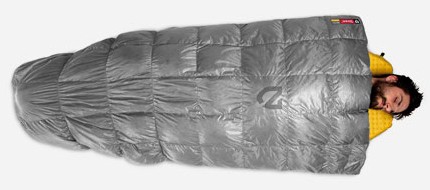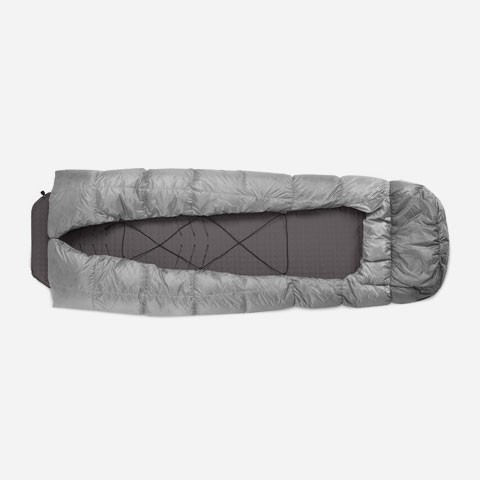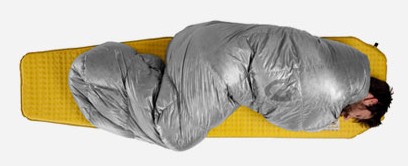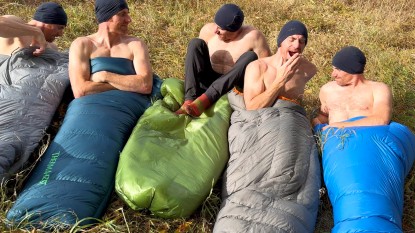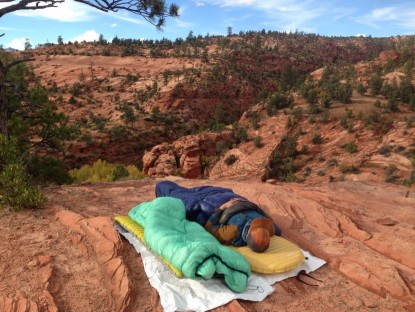Nemo Siren Review
Our Verdict
Our Analysis and Test Results
Likes
The Siren is Nemo's lightest sleeping bag. It weighs 18.6 ounces on our scale, one of the lightest bags we've tested. The Siren uses top quality 850-fill down and a silky smooth 10-denier ripstop nylon. These are some of the best materials available.
As described in detail in our Sleeping Bag Buying Advice, the Siren's quilt style design offers numerous significant performance advantages over traditional style sleeping bags with fixed girths, zippers, and attached hoods. Quilts are by far the best type of sleeping bag for three-season backpacking. These advantages are reflected in our numerical rankings: the bag is lighter, warmer for its weight, more compact, and more versatile than traditional style bags.
Limitations
The Siren has two major drawbacks that significantly reduce its performance: its square box baffles are less versatile than continuous horizontal baffles and its pad attachment system combined with sparse insulation on the bottom of the footbox make it less comfortable and less warm than many other quilts we've tested.
Baffles.The Siren uses box baffles to contain its down. These provide an even layer of warmth but offer reduced performance compared to continuous horizontal baffles that allow you to move the down where you want it. For example, if you want to tuck the quilt underneath your body-- or, with consequences, under a sleeping pad-- continuous horizontal baffles let you shift down from the sides of the bag to the center so that a) it's warmer and b) if you choose to tuck the edges under a pad the down won't get as wet from condensation between the bottom of the pad and the tent/bivy floor. The Siren's box baffles do not provide either of these options. As a result, you have less control over your sleeping bag. The difference between the two baffles is similar to driving an automatic transmission vehicle up a steep and curvy mountain pass. A manual would be better, but you still reach the pass in the automatic.
Although baffle design is a critical component of a down sleeping bag, the pad attachment mechanism on a quilt style bag is arguably the single most important design element. This is where the Siren falls short. It's the only quilt we've tested with a foot box that wraps around and over a 20" wide rectangular sleeping pad. (All other quilts we've tested have a foot box that rests on top of a sleeping pad.) Inserting a pad into the bottom of the bag requires a wide and tall footbox that's heavier than a footbox that would sit on top of a pad. It also reduces the bag's thermal efficiency because you need to heat up more space. Nemo suggests pairing the Siren with their Nemo Zor pad, which is one inch thick. Our testers generally prefer other sleeping pads, some of which are a full inch and a half thicker. Thicker pads are problematic because they leave little space for your feet when a pad is inserted into the Siren; we had to turn our feet sideways because there's not enough space to point them up. Using the Siren with a pad inside the foot box is not comfortable when the upper part of the bag is tucked under the pad. Furthermore, sleeping on your side with a pad tucked under the bag creates drafty dead air spaces that reduce thermal efficiency. See the illustration and photo below. Finally, inserting a pad into a bag can get the bottom insulation wet from condensation on a tent or bivy floor. This is problematic because a) down isn't warm when wet and b) stuffing the bag into a sack for travel can get the neighboring down wet, which further reduces the bag's ability to keep you warm. Thus, tucking a pad inside the Siren is neither comfortable nor thermally efficient. Thankfully, you don't have to do it.
You can also wrap the Siren around your body and lie on top of a sleeping pad. We found that doing this and laying flat on our back was the warmest way to use the Siren. Sleeping on your side with the bag wrapped around you is not warm because cold air comes in through the bottom of the bag.
The Siren has six plastic loops on the bottom of the bag that allow you to rig it up in various other ways. One possible configuration that other quilt makers, such as Nunatak, promote is attaching the bag via two or three straps that pull the side of the bag down and slightly around the edge of the pad. This leaves the footbox and neck area free to move around on top of the pad, which is more comfortable. This is relatively easy to configure with the Siren. Grosgrain and thin plastic buckles are the best way we've seen to do it- check out the Nunatak Arc Alpinist Katabatic Gear Palisade 30 to see how those quilts do it. But, if configured in this way, the Siren has two drawbacks that reduce the bag's warmth.
First, the distance from the bottom end of the bag to the end of the insulation underneath the bag is a mere 11 inches. This the shortest distance of any quilt we've tested and it makes the bag poorly suited for use as a top bag because lifting your feet up or rotating the bag lets in cold air. This greatly reduces the bag's warmth. Other quilts have much longer toe boxes, one might even classify as a “lower leg box” that keeps you warm when lying on your side and back. See the photo below for comparison.
There's no drawcord at the neck
The second factor that reduces the Siren's warmth is its lack of neck drawcord. This is the only sleeping bag we've ever tested that does not have a head/neck drawcord to seal in warm air. Two snaps close the bag around your upper body but leave the tops of your shoulders and neck exposed. This results in a tremendous loss of heat. It's similar to wearing a down jacket without a zipper: you have to actively manage the bag by tucking it around your neck. This is not comfortable and is rarely possible while you're asleep. Moreover, the absence of a drawcord limits the effectiveness of a down hood because the bag can't create a tight seal around the base of the hood. Taller people (5' 11" and up) will find the lack of a drawcord more problematic than shorter people, who can tuck farther into the bag.
Another minor drawback: the plastic drawcord adjustment lies underneath your upper back area and is uncomfortable to lie on. Other bags position the drawcord cinch off to the side or use thin clips that are more comfortable to lie on.
Best Application
The Siren is best at fast and light trips in warm weather.
Value
The Siren retails for $350, which makes it $25 more affordable than our top rated quilts. Given its numerous drawbacks we don't believe it's a good value.
Other Versions and Accessories
The Siren is available in one length and one width. Other companies offer quilts in multiple sizes that maximize thermal efficiency and reduce weight.
The Siren comes with a dry bag style stuff sack that compresses the bag well but is not waterproof. Our testers prefer waterproof stuff sacks for backpacking.



